In response to the changing seasons, our daily routines undergo a subtle transformation.
The transition from the autumn equinox, with its shorter days, to the impending clock change in late October marks the onset of a period when darkness falls earlier, dispelling any hopes of leisurely sunbathing in the afternoon.
For some individuals, this shift can evoke complex and challenging emotions.
Intriguingly, our most recent survey of 2000 respondents, conducted in partnership with Censuswide, reveals that over 70% of UK adults experience sensations of lethargy, restlessness, and reduced energy levels during this seasonal shift.
But did you know that the pair of blinds or curtains you use could also have an impact on your emotional well-being?
As daylight diminishes, it is common to underestimate the profound influence our home environment can exert on our emotional states.
In this blog, we delve into the subtle yet significant impact of home decor, particularly the choice of blinds, in brightening living spaces and, by extension, enhancing overall well-being.

Table of Contents
Toggle1. What is seasonal affective disorder (SAD)?
Seasonal Affective Disorder (SAD) is a specific type of depression that tends to follow a seasonal pattern. Typically, it strikes during the winter months when the days are shorter, and natural light is in short supply. Key symptoms of SAD include a persistent low mood and a loss of interest in usual activities.
However, a lesser-known aspect of SAD is the role our home environment can play in managing these symptoms. Our data suggests that a significant 76.73% of UK adults have recognised the positive impact of adjusting their home surroundings during the winter on their mood.
This statistic underscores the importance of creating a warm, well-lit, and inviting home space, especially during the darker months. It’s not merely about how we feel, but it’s also about our geographical location within the country, the amount of natural light available and these factors collectively influence our overall well-being.
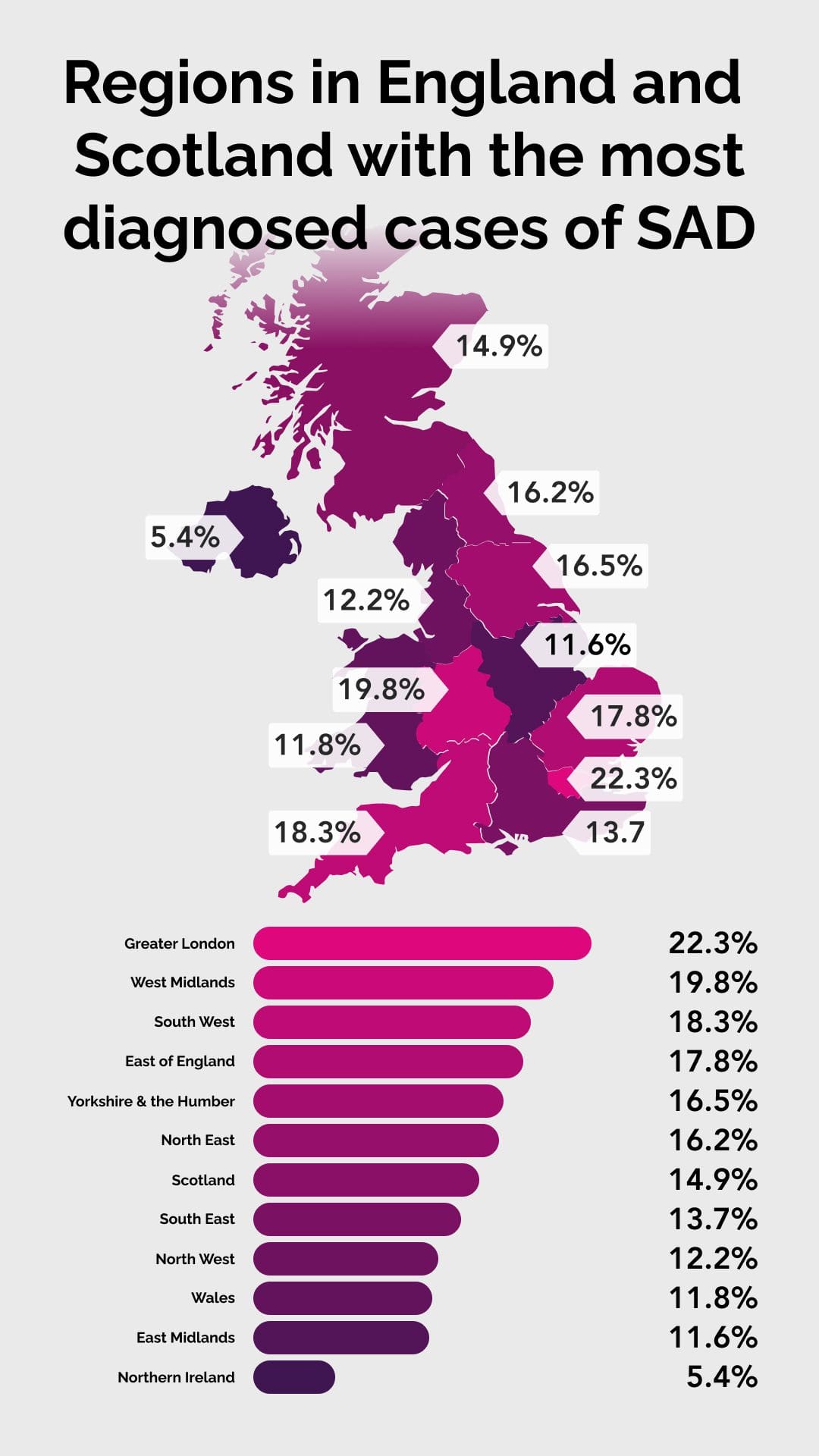
2. The prevalence of SAD: a quick glance
Our data underscores a significant issue: SAD affects a substantial portion of the UK population, with over 16% of adults grappling with this condition year-round, equating to a staggering 10 million individuals.
Of particular note is the striking disparity across age groups, where Gen Z and millennials bear the heaviest burden, with 27% and 26% respectively diagnosed with SAD. Conversely, boomers, aged 55 and older, exhibit the lowest susceptibility, with only 7% receiving a diagnosis.
Norwich has the highest number of people dealing with SAD in the UK, with a substantial 23% of its population affected. In contrast, Belfast has the lowest SAD rate at just 5.45% among adults, with Nottingham following closely behind at 8.85%.
Seasonal affective disorder manifests as recurrent bouts of low mood, typically during the autumn and winter months. This condition’s roots lie in the fluctuation of natural light exposure and its profound impact on emotional well-being.
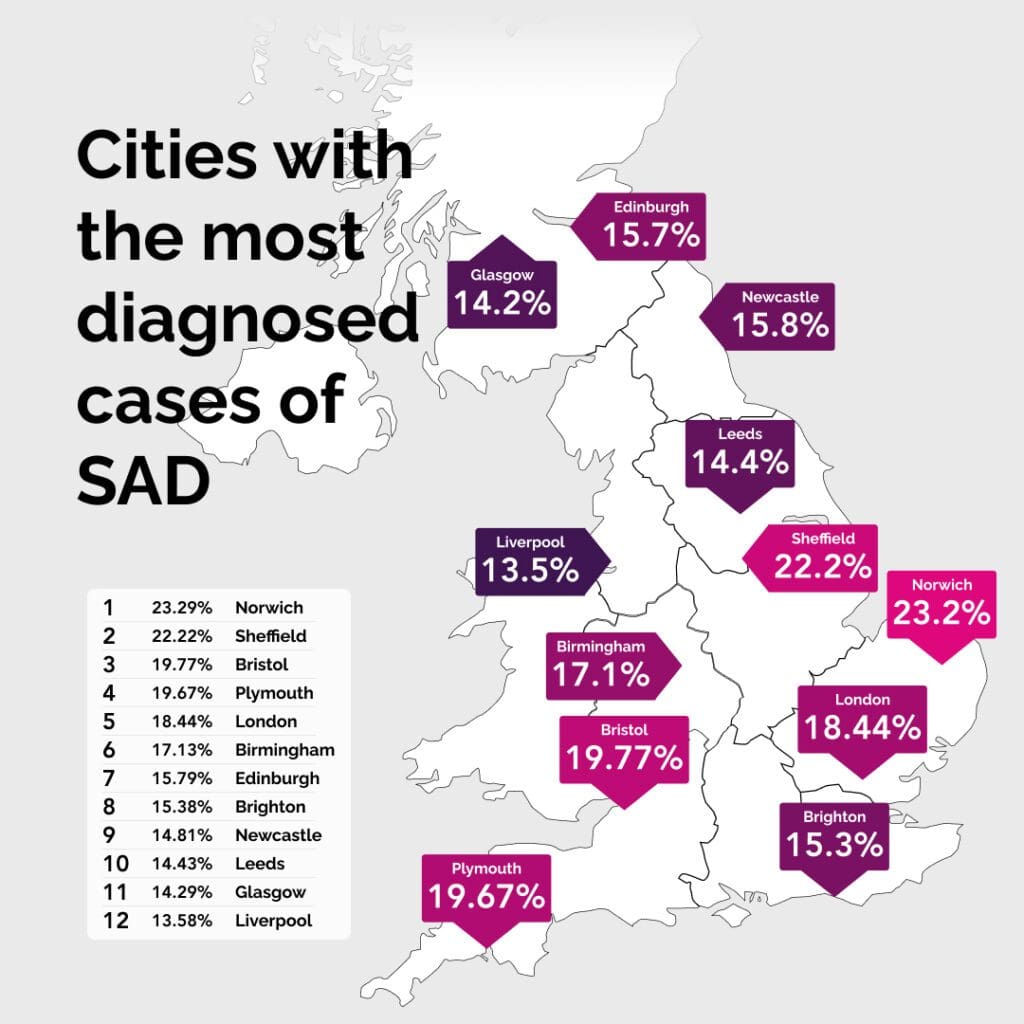
Symptoms of SAD include:
- Depressed Mood: Individuals with SAD often experience persistent feelings of sadness, hopelessness, and low energy
- Increased Sleep: Excessive sleepiness and a greater need for sleep are common SAD symptoms, leading to disrupted sleep patterns
- Weight Changes: SAD can trigger overeating, particularly cravings for carbohydrates, leading to weight gain in some cases
- Loss of Interest: A decreased interest in activities once enjoyed is a hallmark symptom
- Difficulty Concentrating: People with SAD may struggle with concentration and focus
- Social Withdrawal: Individuals may withdraw from social interactions and experience feelings of isolation
3. What Experts Say About SAD
While our data reveals intriguing regional variations in the prevalence of seasonal affective disorder (SAD), it’s essential to delve deeper into the insights shared by experts in the field.
Kamalyn Kaur, Psychotherapist at kamalynkaur.com said: “The exact timing of SAD can vary from person to person however typically, most people will suffer from SAD from October through the winter months and into early Spring.
“Adjusting your home environment, though, can definitely help manage the effects of changing seasons on mood and well-being, especially when it comes to SAD. Some of the things that can help are ensuring your home is well lit, with natural light as much as possible. This will have a positive impact on mood.
“A light box for dark mornings can also be beneficial as it will mimic natural sunlight which can help with regulating your circadian rhythms, increase production of serotonin; and help individuals feel more awake and alert during the day whilst also improving your overall mood.”
Leah Aspinall, Head of Design at the UK’s leading Blinds and Curtains specialist, Blinds 2go, said: “When combating the winter blues, natural light is your best ally. The right blinds can help you harness this powerful mood-enhancer.”
“Opt for blinds that allow ample sunlight to filter through while still maintaining your privacy. This not only brightens your living space but also boosts your mood by providing a dose of sunshine, even on the darkest days.”
Our data also shows what Brits are doing in their every-day life to combat mood changes once it gets darker outside. Thus, almost 30% of us prefer socialising with our friends and family whilst 22.3% like getting more natural light in their house.
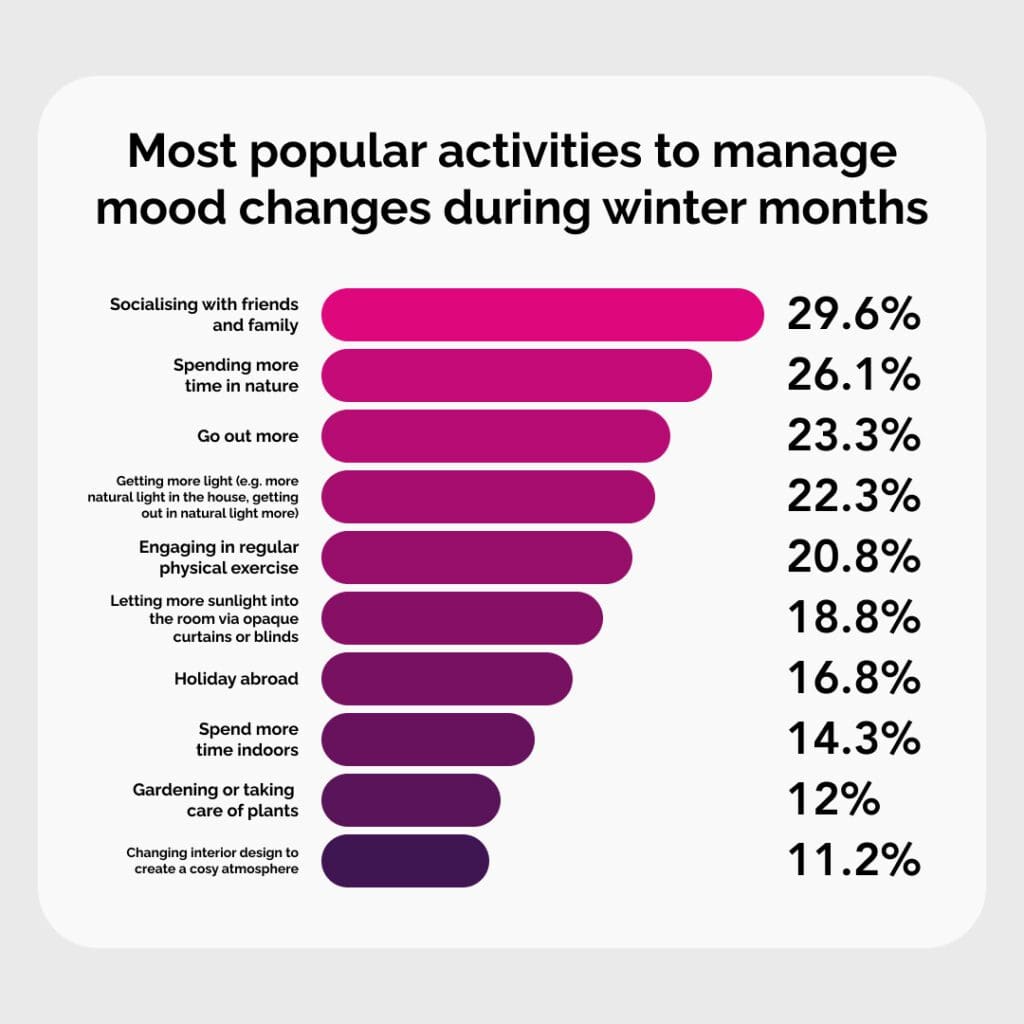
4. The role of blinds in improving mood
Maximising natural light exposure is key to combating winter lethargy. Over 40% of Brits choose to enhance their home lighting, either through abundant natural light or the use of appropriate window treatments, according to Blinds 2go’s latest survey.
Leah Aspinall, Head of Design at the UK’s online leading blinds and curtains specialist, Blinds 2go, said:
“Embrace shorter daylight hours by actively seeking out natural light and doing everything you can to welcome it into your home. Consider blinds in light colours that attract and diffuse sunlight, such as venetian or vertical blinds, perfect for larger windows. These can be easily adjusted to welcome sunlight into your space.
“Another effective choice is pleated blinds, available in various opacities, including sheer options, with a unique cell design that diffuses light and provides insulation.
“Open your blinds and curtains during the day, spend time outdoors, and position yourself near windows when working or relaxing. Harnessing the power of natural light can help regulate your circadian rhythm and uplift your mood.”
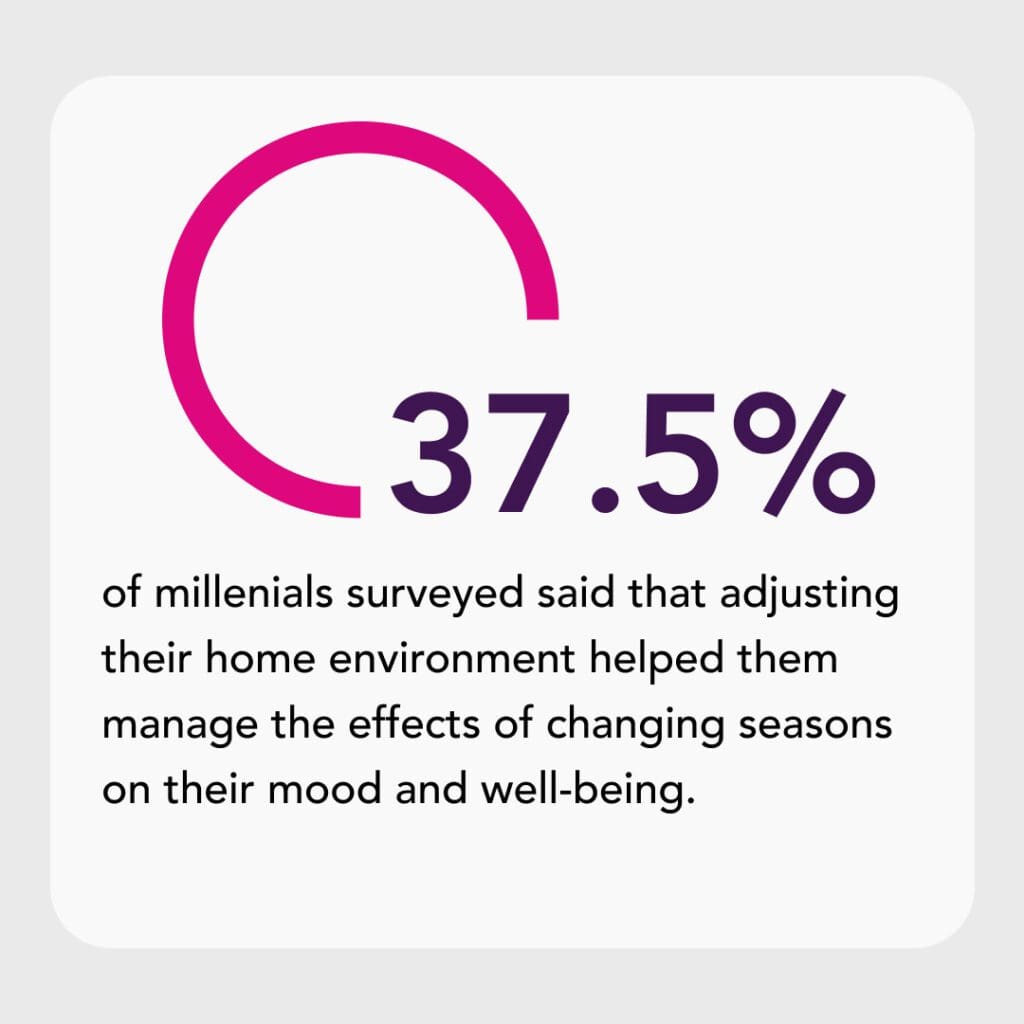
5. Tips for choosing the right blinds to combat the winter blues
Choosing the right blinds isn’t just about enhancing your home; it’s also a positive step towards combating the winter blues and brightening your mood. Here are our experts’ top tips to choosing the right pair of blinds for bringing a lot of light into your home:
- Material Considerations: Selecting the right materials for your blinds is crucial. Sheer or light-coloured fabrics are excellent choices as they allow natural light to flood your space while still offering you privacy. Avoid heavy, dark materials that can block out valuable sunlight.
- Colour Psychology: When it comes to blinds, colour matters. Consider shades like pale yellow, soft green, or calming light blue to promote a mood-boosting environment. Experiment with these colours to see which one resonates with you the most.
- Adjustable Blinds: Opt for blinds that offer adjustable slats. This allows you to control the amount of natural light entering your space throughout the day. You can angle the slats to let in more light during the day and close them for privacy in the evening.
- Top-Down/Bottom-Up Blinds: These versatile blinds can be adjusted from both the top and the bottom, providing excellent flexibility. You can lower the top to allow sunlight while maintaining privacy at eye level.
- Sheer or Light-Filtering Blinds: Choose blinds made from sheer or light-filtering materials. These materials allow natural light to gently diffuse into the room, creating a soft and welcoming ambiance.
- Warm Colours: When selecting the colour of your blinds, consider warm and cheerful hues like soft yellows, warm oranges, or light shades of red. These colours can evoke a sense of warmth and positivity in your living space.
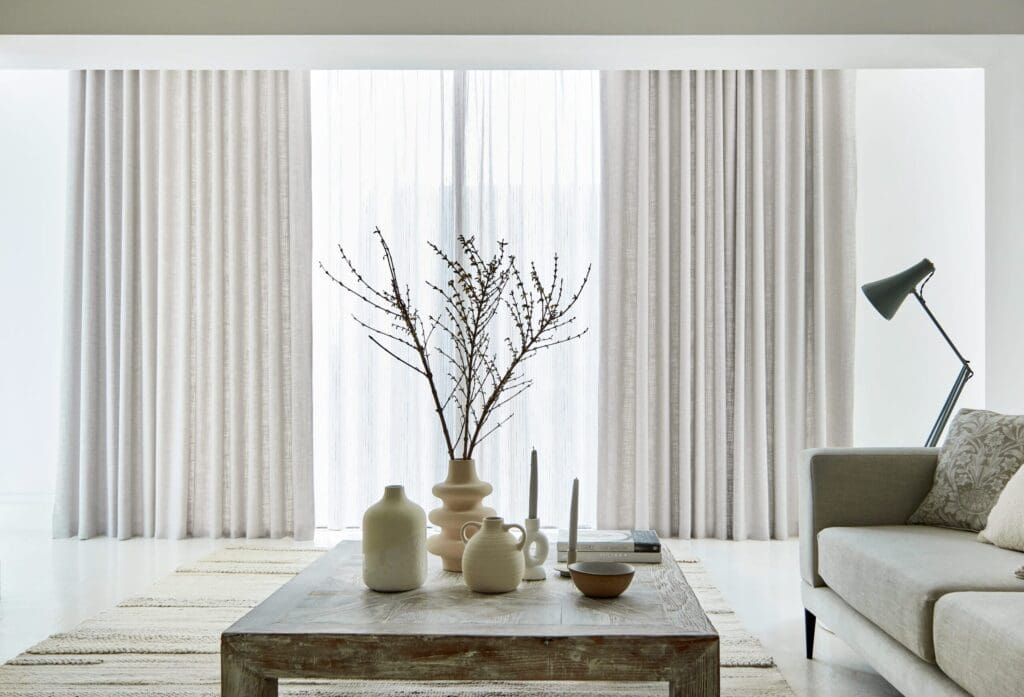
7. Conclusion
Understanding the impact of SAD and the simplicity of home adjustments underscores the potential for brighter days even during the darkest of seasons. Consider how small changes in your home, such as choosing the right blinds, can cast a radiant light on your mood and overall mental well-being.
For those who need more support, we recommend speaking to your GP or a trained therapist about your symptoms. Alternatively, these organisations will also be able to help:
- Samaritans. To talk about anything that is upsetting you, you can contact Samaritans 24 hours a day, 365 days a year. You can call 116 123 (free from any phone)
- SANEline. If you’re experiencing a mental health problem or supporting someone else, you can call SANEline on 0300 304 7000 (4.30pm–10.30pm every day).
- Shout. If you would prefer not to talk but want some mental health support, you could text SHOUT to 85258. Shout offers a confidential 24/7 text service providing support if you are in crisis and need immediate help.



